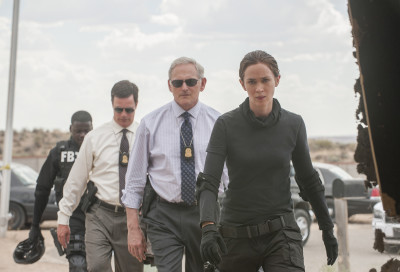
Director Denis Villenueve, with his multifaceted approach to the war against drugs between the United States and Mexico, and cinematographer Roger Deakins, with his beautiful technical construction, combined to create an emotive and riveting experience for their audience in their new film “Sicario.”
In the film, FBI investigator Kate Macer (Emily Blunt) joins the enigmatic Alejandro (Benicio Del Toro) and the flip flop-wearing Matt Graver (Josh Brolin) on a mission to take out a Mexican drug cartel boss. Despite volunteering for this task force, Kate is unclear as to what the true objective of the mission is and what the mission entails. And as the story unfolds and rules are constantly broken, Kate’s moral dilemma remains a recurring theme.
By creating a film about a Mexican drug cartel, it would have been easy for Villenueve to incorporate guns, drugs and violence exclusively as a means of entertaining the audience. Instead, he goes beyond that, highlighting the ethical ambiguity of the individuals involved.
The audience is constantly at odds with who the villains truly are. With a scene of a corrupt, drug-trafficking policeman at home with his family, viewers sympathize with the enemy from the start. But while the audience’s loyalty sways back and forth between the two sides throughout the film, Kate still remains the central protagonist of “Sicario,” despite the fact that she teams up with the law-breaking, cartel-busting government task force.
Cinematographer Roger Deakins creates scenes rich with visual beauty and nuanced technical construction that make each sequence foreboding and aesthetically exquisite. Notable for his work in films such as “The Shawshank Redemption” and “Skyfall,” among others, Deakins proves that he is as versatile as he is skillful. Deakins uses a color scheme that works with pigments in the Mexican and Texan skies to create colorful and artistic scenes of landscapes. He is able to add another dimension to the film by embedding a melancholic beauty that lurks beneath the plot.
Moreover, the film provides a refreshing perspective by focusing on Kate’s moral dilemma. Not quite an action thriller and not quite a drama, the film is able to synthesize the entertaining action with the psychological struggle Kate experiences, ultimately escalating the film’s credibility.
Kate is strong and capable, but as the film progresses, her own values continue to conflict with those of the task force. She often blunders, and makes the wrong call more than one time. She makes one large mistake by volunteering for a job despite being aware of the fact that she had no idea what she was getting into.
Another mistake was almost sleeping with a man that was using her as bait. At the end of the film, Kate is left with much of the doubts that she already had. “Only wolves can fight wolves,” Alejandro says to her in his characteristically mysterious manner. Once again, the fine line between good and evil is blurred, and Kate is left feeling defeated.
Although the surrounding characters are poorly developed, Villenueve is able to trump overdone clichés with his development of the female protagonist. Kate is never characterized as the badass alpha dog in a male-dominated field. Nor is she the marginalized and misunderstood woman that redeems herself in the end by tying all the loose threads up in the war on drugs. Instead, Villenueve removes the artifice of a typical female protagonist and portrays Kate as who she is — a strong-willed woman and, above all, a human being.
“Sicario” is now playing in theaters nationwide.
























































































































